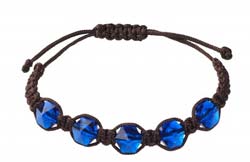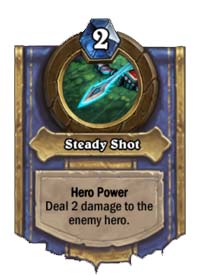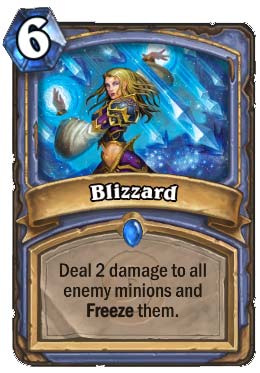|
|
|||||
| Pojo's Hearthstone news, tips, strategies and more! | |||||
|
|
|||||
 |
|||||
|
|
|||||
|
BMoor
Warcraft Home
Magic
This Space |
BMoor on Hearthstone
Greetings! My name is B'Moor, and some of you may
remember me from my old Deck Garage articles on Pojo's
Magic: the Gathering site. Others of you may not remember
me, because it's been quite a long time since I've actually
written one. The reasons for my long absence are myriad, but
the basic story is that troubles in my personal life made it
too hard for me to keep up with Magic: the Gathering closely
enough to feel comfortable presenting myself as a source of
advice on it.
Much of this was due to financial insecurity-- it's
no secret that Magic: the Gathering is not a cheap game to
play if you want to be competitive to any degree. During
that time, I instead chose to fulfill my card-slinging itch
with the new, high-tech game on the block, Hearthstone.
Based heavily on the lore and general aesthetic of World of
Warcraft, another game I once played back when money was
less of an issue, Hearthstone does a good job of capturing
the general feel of WoW while employing mechanics similar
enough to Magic that skill in one game can easily transfer
over to the other.
Magic has lands; Hearthstone has
mana crystals.
This is more than just a different game
Hearthstone, javing been created over a
Magic has colors of mana;
Hearthstone has classes and hero powers.
Magic: the Gathering, famously, has five colors of mana.
Hearthstone, built on the Warcraft mythology,
Your class isn't just your available card pool
either, it also gives you a “hero power”. A hero power, in
Magic terms, is an activated ability that costs 2 mana and
may be used once each turn. Each class's power is different,
and many of that class's cards complement or interact with
the hero power in a way that helps to dictate what that
class's general strategies are. The Hunter's power, for
example, deals 2 damage directly to the enemy. This damage
can't be blocked or prevented and the Hunter has access to
it every turn, so hunter decks tend to be aggro-oriented.
The Mage's power, by contrast, only deals 1 damage, but can
be aimed at the opponent directly or at his or her minions.
Mages aren't as good at pure aggro as hunters, but they are
much better at spot removal and board control.
Magic is made of physical cards;
Hearthstone's “cards” are digital constructs thereof.
This seems like stating the obvious, but the
implications can be quite surprising for someone who is used
to one game just getting comfortable with the other.
For example, Magic distinguishes between a card's
“controller” (the person whose side of the board it is on)
and its “owner” (the person who showed up at the table with
it in his deck) and has always had an unspoken rule that if
a card moves to any zone other than “in play”, it moves to
the zone of its owner. The “ante” rule from Magic's infancy
was discontinued for this exact reason-- having your
opponent shuffle that chase rare you spent $20 on into his
own library and then “forget” to give it back after the game
is a recipe for trouble. Since Hearthstone cards are kept
track of via a database, there's no reason to enforce such a
rule. Your opponent can put copies of your cards into his
own deck, and after the game is over, the server remembers
both your deck lists so you always have all your own cards.
This also means that you can easily maintain multiple decks
containing the same cards without having to own multiple
play sets, or take apart one deck whenever you want to play
the other.
Hearthstone cards can also generate other cards:
cards that exist in the database but are “uncollectible” and
thus aren't in your deck and never exist outside of a game.
Magic can do a similar trick with “tokens”, but has long
established that tokens only exist if they're in play-- once
they would be moved to any other zone, they no longer exist.
Tokens in Magic must also have all their rules text
described on the card that generated them, limiting their
potential for complexity due to word count and legibility
issues. Hearthstone can simply refer to any card in the game
by name, because the database knows what the card's stats
are even if neither player does.
Having the game be run on a computer also means that
the computer is responsible for the rules of the game. It
knows how all possible card combinations interact, and it
knows how they work. There are no judges, and no punishment
system for rule infractions at official events, because you
can't actually “break” the rules-- however the server
interprets your inputs is the “correct” interpretation. You
also, however, can never ask a judge at an event about a
rules question if it comes up during a game. All you can do
is play based on how you believe the rules work, and if
you’re wrong, well, too bad. You can't take back moves in
Hearthstone, not even in Casual play.
Magic has a complex layered
system by which players can interact with each other's
moves; Hearthstone has discreet turns of one minute each.
Part of what makes Magic so strategically in-depth (and so
intimidating for new players) is the high level of
interactivity. You can respond to everything your opponent
does through instants and activated abilities, and you
frequently have important tactical decisions to make on your
opponent's turn due to combat tricks and the like. Those who
have played Magic Online will tell you that this is the
primary problem with it: waiting for your opponent to
manually pass priority for each step and after each spell
makes every turn crawl at a snail's pace compared to live
Magic, where you can just play at conversational speed and
tell your opponent to stop when you have a response.
The people who created Hearthstone were well aware of
this issue, so Hearthstone does not expect (or allow) your
opponent to have any input during your turn. This means that
each player's turn can be capped at one minute to prevent
slow play. If you run out of time during your turn, you will
be penalized with progressively less time next turn, down to
a minimum of 10 seconds. Your timer will reset once you make
a play, though-- the penalty is primarily to stop players
from going AFK.
In
Magic, your creatures all attack in one wave, aimed at your
opponent, and your opponent may then assign blockers. In
Hearthstone, each minion attacks independently, and the
attacker gets to choose the target.
This consideration has probably made the most difference
between how the two games play out. In Magic, the more
creatures on the board, the harder it is to launch a
successful attack, even if our creatures seem to be better
on average, simply because the defender can choose who
blocks what and can even “gang block” with two or more
creatures to take out a bigger creature. Magic even has a
keyword ability-- menace-- that requires a defender to do
this to a creature bearing it. Hearthstone, by contrast,
favors the attacker in such a situation, as each minion can
be aimed at the target of the attacker's choice. Instead of
a defender “gang-blocking”, the attacker can “gang up” on a
larger minion to take it out, but doing so allows the victim
to deal its full attack power back to each assailant. The
ability to choose targets also means that minions can also
double as minion removal. If a minion has a strong ability,
a Hearthstone player must take more active measures to
protect it from both kill spells and attacking minions. One
way to do this is with the Taunt mechanic, which requires
attackers to attack a target with Taunt before being allowed
to attack non-Taunt targets. Your opponent's own life total
never has Taunt, so it is also favored as a way to keep
yourself alive.
Magic has creatures, artifacts,
enchantments, instants, sorceries, lands, and planeswalkers.
Hearthstone has minion, spells, weapons, and your Hero
Power.
Since you can't play spells during your
These are the most obvious differences to players of
one game who are just trying out the other, but the more
subtle differences give the two games very different
strategic identities and make them two very different
experiences. It is my hope that by writing this article, I
have given players of both games a new way to look at their
favorite of the two, and perhaps given players of each game
a reason to give the other a try.
It is also my hope that this won't be just a
temporary return for me to Pojo, and that I'll be able to
offer my insights on both games to an interested audience in
the future! Until then, here's wishing you all the luck of
the draw!
~B'Moor
|
||||
|
Copyrightę 1998-2007 pojo.com This site is not sponsored, endorsed, or otherwise affiliated with any of the companies or products featured on this site. This is not an Official Site. |
|||||

 decade later,
had all this work laid out for them upon creation and
decided that mana should not be dependant on card draws. In
Hearthstone, you gain one mana crystal per turn as surely as
you draw a card each turn, up to a maximum of 10. There are
no cards that cost more than 10 without a built-in
cost-reducer effect. There are also currently no ways to
reduce the amount of mana crystals your opponent has,
although there are a few ways to give yourself AND your
opponent more of them. Both games have mostly restricted
this ability to one type of cards-- Green cards in Magic,
and Druid cards in Hearthstone, though exceptions exist.
Which brinsg em to my next point...
decade later,
had all this work laid out for them upon creation and
decided that mana should not be dependant on card draws. In
Hearthstone, you gain one mana crystal per turn as surely as
you draw a card each turn, up to a maximum of 10. There are
no cards that cost more than 10 without a built-in
cost-reducer effect. There are also currently no ways to
reduce the amount of mana crystals your opponent has,
although there are a few ways to give yourself AND your
opponent more of them. Both games have mostly restricted
this ability to one type of cards-- Green cards in Magic,
and Druid cards in Hearthstone, though exceptions exist.
Which brinsg em to my next point... is
having precisely none of this. Mana is mana, and it fuels
spells. In lieu of Magic's five-color system, Hearthstone
has nine classes corresponding to the nine playable classes
in vanilla WoW. Which spells you can or can't cast depends
on your class. You must choose a class as part of deck
construction, and you may use only cards of your chosen
class or neutral cards. There are, however, ways for cards
you didn't put in your deck to end up in your hand, and if
this happens then you can cast them normally without
worrying about having the right type of mana. The Priest
class is the one that most specializes in this type of
effect, having “mind control magic” effects in WoW. Rogues
are catching up to them in this respect though, thanks to
being the class most likely to outright steal things.
is
having precisely none of this. Mana is mana, and it fuels
spells. In lieu of Magic's five-color system, Hearthstone
has nine classes corresponding to the nine playable classes
in vanilla WoW. Which spells you can or can't cast depends
on your class. You must choose a class as part of deck
construction, and you may use only cards of your chosen
class or neutral cards. There are, however, ways for cards
you didn't put in your deck to end up in your hand, and if
this happens then you can cast them normally without
worrying about having the right type of mana. The Priest
class is the one that most specializes in this type of
effect, having “mind control magic” effects in WoW. Rogues
are catching up to them in this respect though, thanks to
being the class most likely to outright steal things. opponent’s
turn in Hearthstone, there is no need to differentiate
between different types of spells the way Magic does. The
closest Hearthstone has are “secrets”, which function much
like Trap Cards in Yu-Gi-Oh: your opponent can see that you
played one, but not which one, and they wait for a certain
action on your opponent's turn to trigger them. Hearthstone
also doesn't need lands the way Magic does, nor does it have
room on the battlefield for non-minion entities. Things that
Magic would represent as an artifact or enchantment are
instead represented as a spell with a permanent effect on a
minion, a 0-power minion (much like Walls in Magic are), or
a weapon. Weapons give Hearthstone a functionality that
Magic does not: they allow YOU to attack a minion or your
opponent yourself instead of leaving your minions the task.
Weapons have a set number of uses and typically can be used
once per turn. This lets you kill an enemy minion to clear
the way for your own board, at the cost of taking some
damage, or to simply push more damage at the opponent
through. Your weapon is not active during your opponent's
turn, however, so it does not allow you to damage or kill
anything that chooses to attack you.
opponent’s
turn in Hearthstone, there is no need to differentiate
between different types of spells the way Magic does. The
closest Hearthstone has are “secrets”, which function much
like Trap Cards in Yu-Gi-Oh: your opponent can see that you
played one, but not which one, and they wait for a certain
action on your opponent's turn to trigger them. Hearthstone
also doesn't need lands the way Magic does, nor does it have
room on the battlefield for non-minion entities. Things that
Magic would represent as an artifact or enchantment are
instead represented as a spell with a permanent effect on a
minion, a 0-power minion (much like Walls in Magic are), or
a weapon. Weapons give Hearthstone a functionality that
Magic does not: they allow YOU to attack a minion or your
opponent yourself instead of leaving your minions the task.
Weapons have a set number of uses and typically can be used
once per turn. This lets you kill an enemy minion to clear
the way for your own board, at the cost of taking some
damage, or to simply push more damage at the opponent
through. Your weapon is not active during your opponent's
turn, however, so it does not allow you to damage or kill
anything that chooses to attack you.